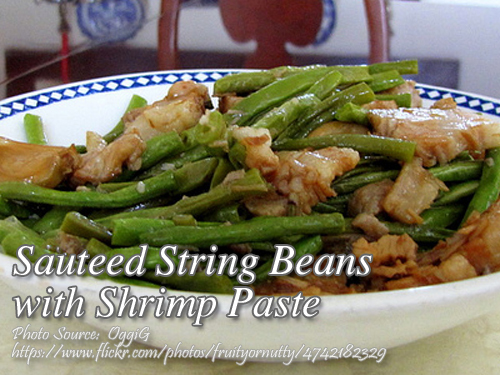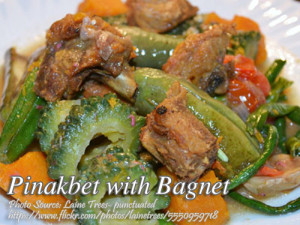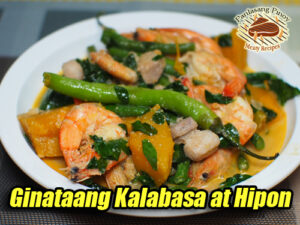Sauteed string beans or ginisang sitaw is one of the most common vegetable recipes that is easy to cook. There are many varieties of string beans and the one used in this recipe is called “sitaw” or “snake bean” which is the one of the English term to distinguish it to the common name string beans. Comparing this dish to pinakbet, I guess it is very close just omitting the other vegetables like the eggplant, okra, bitter gourd and squash.
A Taste of Home: Sauteed String Beans with Shrimp Paste
Growing up in a family where food plays a part and parcel of every celebration, ginisang sitaw was staple on our dinner table. I can still vividly remember how my Tita Lily, our family’s unofficial cook would prepare for us this humble dish which gathers everyone, if it’s just an ordinary meal on any regular weekday or any celebration. The savory flavors of shrimp paste mixed well with the tender-crisp string beans and would become a lasting impression on my taste buds. Every time I cook it, I get transported back to that family moment that feels like a warm hug.
This specific dish is basic but rooted deep within the heritage of Filipino cooking. Known as ginisang sitaw in Tagalog, it features the longer and thinner snake beans that resemble regular green beans, combined with the deep umami taste bagoong alamang or fermented shrimp paste. With this dish, when you craved something like pinakbet but wanted to have an easier and quicker version, here is your answer.
The Importance of Sitaw in Filipino Cuisine
Sitaw, or snake beans, was a staple vegetable at home, especially in the provinces. My Lolo Nanding was a Bulakenyo boy who would always tell me that sitaw dominated his backyard when he was growing up. He would say that the way his mother prepared them varied according to whatever is available at that time. She would sometimes add coconut milk to it, and other times some dried fish. But one thing remained constant-ginisang sitaw was always on the menu.
Interestingly, sitaw isn’t only limited to Filipino cuisine. It is very popular all over Asia and especially throughout Southeast Asia, but its version in the Philippines is uniquely great due to the shrimp paste being used here. Freshness, crunchiness of beans, and that savory-salty kick brought about by bagoong give an utterly Pinoy balance.
The Major Ingredients: Bagoong Alamang and Gabi
The star of this dish is not the string beans. It’s the bagoong alamang. Guess what-the Philippines loves this ingredient, in that every vegetable-be it kangkong, talong, and more-they would add a few dashes of it. For the first time that I started cooking this, I was so baffled as to how much to put. I was recalling how I once called up my uncle, Tony, who was a chef in one of the local eateries back in Quezon City. And he said to me, “Start small because bagoong has quite an overwhelming flavor.” He also emphasized good-quality shrimp paste, but not too salty such that it will perfectly blend with the beans and pork.
Another ingredient that makes this dish a bit heavier in texture is the gabi or taro root. My Ate Linda, who spent time in Laguna, shared with me that this was not used in all versions of ginisang sitaw, but it was common in her region. The gabi adds a subtle creaminess to the dish, soaking up all the flavors and giving each bite a comforting, starchy quality that contrasts so nicely with the snap of the beans.
Simple Process with Deep Flavours
The cooking process for this recipe is extremely simple yet as deep in flavour as one can possibly imagine. The process begins by boiling pork cubes until they are soft and infuse their natural flavours into the water. In actuality, magic occurs where you sauté garlic, onions, and tomatoes together. This smell of aroma fills the entire kitchen immediately, reminding me of the Sunday lunches we had at home. Often I joke with my Kuya Ben that this smell alone will make you hungry.
The pork makes sure that after returning the pork and bagoong alamang to the pot, aromatics had infused their flavors into the meat. That is what makes every bite so satisfying – the savored salty flavors from the bagoong. Some versions of this omit pork for vegetarian friendliness, but not my family. My family just won’t do it without pork in there, that would be incomplete essence.
Add the gabi. This takes a little longer time to cook in the pot than the beans. In its almost tender stage, add the snake beans. Watch out since these will get mushy very quickly. While I relish my beans both crisp-tender and just the right bite, adding texture to each mouthful, I readily agree with the fact that every Filipino home has a sweet memory of drinking a steaming cup of coffee or cocoa after helping Mom in the kitchen prepare this wonderful, culinary traditional dish.
A Nostalgic Filipino Meal
This dish isn’t just for hunger but a way of keeping your feet grounded in the root. I remember how my family, who were all over this very huge country in different provinces, could find their way home together during fiestas and holidays with the same big serving of ginisang sitaw on the table. We’d all gather ’round and chat with each spoonful being a little taste of home. I could say that even until now that far away from those family meals, cooking this dish brings me a feeling of belongingness and connection with my place.
If this is your first time making ginisang sitaw, do not worry. It is one of those dishes that look much more complicated than it really is. Heck, it’s perfect for newbies. Just a little patience, and a willingness to experiment with a little flavor here and there, and you’re set. You’ll have that comforting savory meal brought to the heart of Filipino cooking.
A Dish Full of Memories
Every time I make this, I remember my family – that each one was a little part of the recipe. Whether it was the careful sautéing of my Tita Lily, the precise use of bagoong by Uncle Tony, or adding gabi like what my Ate Linda suggested to do, this dish carries a little of all of them. And now, it’s something I can pass on, not just a recipe but a shared memory of home. So, if you’d like to recreate some of that warmth in your kitchen, here is a great recipe to start with.
How to Cook Sauteed String Beans with Shrimp Paste
Ingredients
- 20 pcs string beans or sitaw cut into 2" long
- 200 grams pork cut into small cubes
- 5 pcs small gabi or taro roots peeled and cut into 4 pcs
- 1 pc onion chopped
- 3 pcs tomatoes sliced
- 3 cloves garlic crushed
- 1/4 cup shrimp paste or bagoong alamang
- 1 tsp. MSG (optional)
- 2 Tbsp. cooking oil
Instructions
How to cook Sauteed String Beans with Shrimp Paste:
- Boil pork cubes in 1/4 cup water. Cook until tender and set aside.
- Saute garlic until brown. Add onion and tomatoes and saute for 2 minutes.
- Add pork and bagoong alamang then stir cook for 5 minutes.
- Add gabi and pour in 1/2 cup water. Cover and continue cooking.
- Add string beans when taro roots are almost cooked.
- Add another 1/2 cup water and cook until string beans are done but not overcooked.
Notes
Cooking Tips:
Do Not Overcook the Beans
To cook your green string beans to the perfect texture, you should cook them only until they are crisp-tender. Overcooking makes them mushy and that really detracts from the overall appeal of the dish. So, keep looking at your beans. The moment they turn a bright, fresh green, take them off the fire.Balance the Saltiness of Shrimp Paste
Shrimp paste is very salty, so add a little bit at a time for better control. If excess has been added, adding a little water or tomatoes can dilute the flavor as desired. Taste along the way for an ideal balance.Tenderize the Pork Properly
Boil the pork cubes until very tender, sauté it with some garlic, onions, and tomatoes. This makes sure the pork stays juicy and picks up savory flavors of shrimp paste. This tender pork raises the texture and richness value of the meal so that every bite does well.





